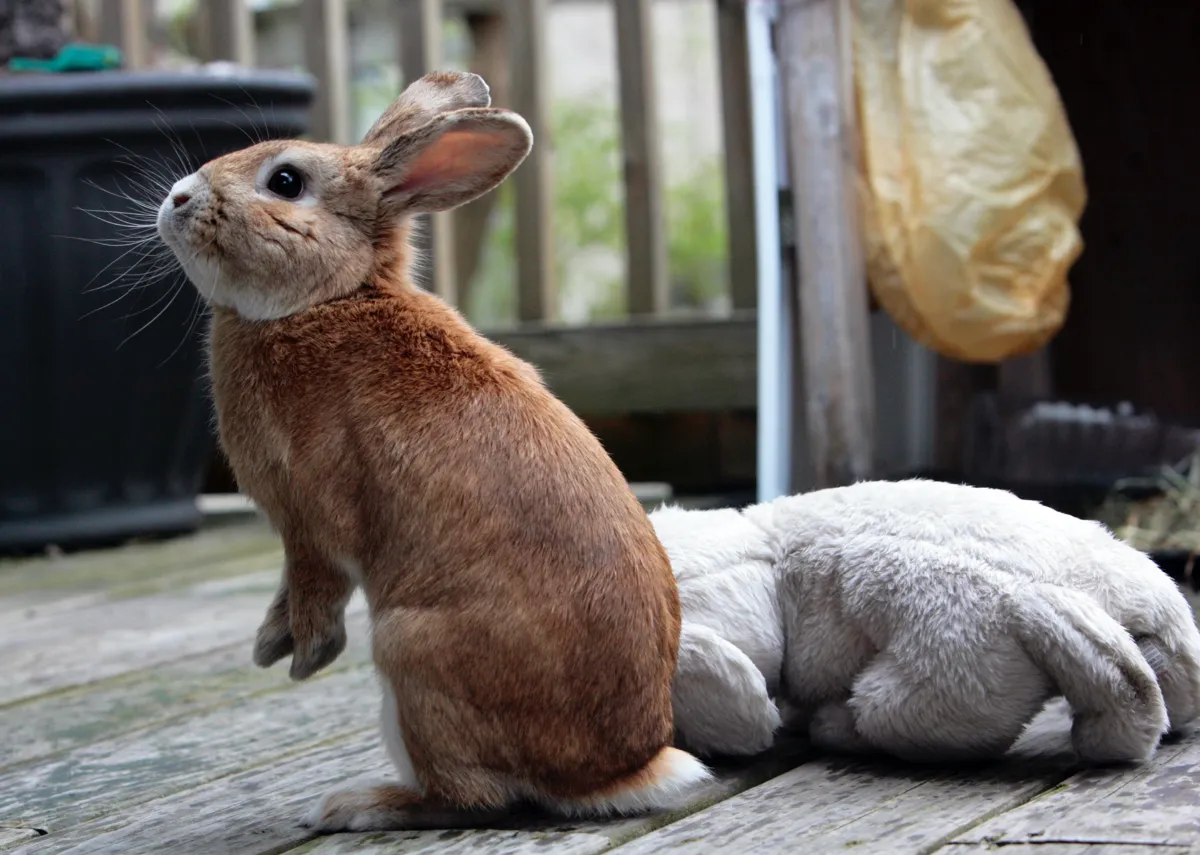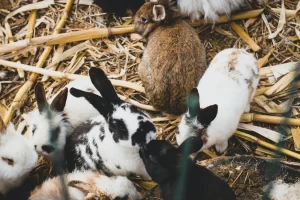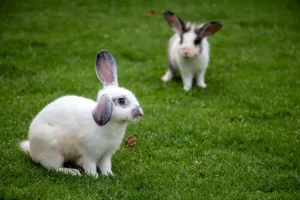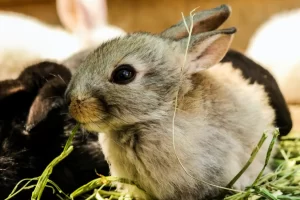Are you faced with a rabbit suffering from GI stasis? Don’t fret, for there are ways you can help your furry friend right at home.
By recognizing the signs, providing comfort, encouraging hydration, promoting gentle exercise, adjusting the diet, utilizing natural remedies, monitoring pain, and seeking veterinary guidance, you can play a vital role in treating GI stasis in rabbits.
Let’s dive into these methods and ensure your rabbit’s well-being in the comfort of your own home.
In This Article
- 1 Key Takeaways
- 2 Recognizing the Signs of GI Stasis
- 3 Providing Comfort and Stress Reduction
- 4 Encouraging Hydration and Fluid Intake
- 5 Promoting Gentle Exercise and Movement
- 6 Adjusting the Diet to Aid Digestion
- 7 Utilizing Natural Remedies and Supplements
- 8 Monitoring and Managing Pain
- 9 Seeking Veterinary Guidance and Support
- 10 Frequently Asked Questions
- 10.1 Can GI Stasis Be Prevented in Rabbits?
- 10.2 How Long Does It Typically Take for a Rabbit to Recover From GI Stasis?
- 10.3 Are There Any Long-Term Effects of GI Stasis on a Rabbit’s Health?
- 10.4 Can Rabbits With GI Stasis Still Eat Their Regular Diet?
- 10.5 Are There Any Alternative Treatments for GI Stasis Besides the Ones Mentioned in the Article?
- 11 Conclusion
Key Takeaways
- Recognize the signs of GI stasis in rabbits, such as decreased appetite, decreased fecal output, lethargy, and abdominal discomfort
- Promote hydration by providing fresh water at all times, offering water-rich vegetables, adding water to their food, or using a syringe to administer water if needed
- Encourage movement and exercise by providing a spacious and stimulating environment, offering toys and tunnels, allowing supervised outdoor time, and engaging in interactive play sessions
- Make dietary changes by increasing hay intake, introducing fiber-rich vegetables, avoiding high-carbohydrate treats, and providing small, frequent meals throughout the day
Recognizing the Signs of GI Stasis
You should be aware of the five key signs of GI stasis in rabbits. GI stasis, also known as gastrointestinal stasis, is a serious condition that affects a rabbit’s digestive system.
The first sign to watch for is a decrease in appetite. If your rabbit suddenly stops eating or shows a decreased interest in food, it could be a sign of GI stasis.
Another common sign is a decrease in fecal output. If you notice that your rabbit is producing fewer or smaller droppings, it’s important to take action.
Other signs include lethargy, abdominal discomfort, and a bloated stomach. It’s crucial to recognize these signs early on as GI stasis can have serious consequences if left untreated.
Common causes of GI stasis include a poor diet, lack of exercise, stress, and dehydration.
To prevent GI stasis, ensure your rabbit has a balanced diet rich in fiber, provide plenty of opportunities for exercise, and keep them hydrated. Regular check-ups with a veterinarian can also help detect any potential issues before they become serious.
Providing Comfort and Stress Reduction
To ensure comfort and reduce stress for your rabbit, try providing soft bedding and plenty of opportunities for relaxation, such as hiding spots and gentle petting.
Creating a calm environment for your rabbit is essential for their overall well-being. Here are four ways to promote a serene atmosphere:
- Soft Bedding: Use soft materials like hay or shredded paper for your rabbit’s bedding. This will provide them with a cozy and comfortable space to rest and relax.
- Hiding Spots: Rabbits love to have their own hideaways where they can retreat and feel safe. Consider providing them with tunnels, boxes, or even specially designed hiding spots that they can explore and enjoy.
- Gentle Petting: Rabbits enjoy gentle strokes and petting from their owners. Take the time to bond with your rabbit by gently stroking them, allowing them to feel loved and secure.
- Implement Bonding Activities: Engage in activities that promote bonding between you and your rabbit. This can include playing with toys, teaching them tricks, or even just spending quality time together.
Encouraging Hydration and Fluid Intake
When it comes to encouraging hydration and fluid intake for your rabbit, it’s important to provide fresh water and offer juicy fruits and vegetables. Hydration techniques and fluid intake methods play a crucial role in maintaining your rabbit’s overall health and well-being. Here are some tips to ensure your furry friend stays hydrated:
| Hydration Techniques | Fluid Intake Methods |
|---|---|
| Provide fresh water daily | Offer juicy fruits and vegetables |
| Use a water bottle or bowl to make water accessible | Incorporate moist foods into their diet |
| Monitor water intake and refill as needed | Make ice cubes with flavored water for a refreshing treat |
| Offer water-rich vegetables like lettuce and cucumber | Encourage your rabbit to drink by gently petting and offering treats |
| Consider adding a water bowl in addition to a bottle for variety | Provide a quiet and stress-free environment for drinking |
Promoting Gentle Exercise and Movement
Encouraging gentle exercise and movement in your rabbit can help improve digestion and prevent GI stasis. Here are some strategies to promote movement in rabbits:
- Provide a spacious enclosure: Ensure that your rabbit has enough space to move around and stretch its legs. A larger enclosure allows for more opportunities for exercise.
- Offer toys and tunnels: Stimulate your rabbit’s natural instincts by providing toys and tunnels for it to explore and play with. This encourages movement and keeps your rabbit mentally and physically active.
- Schedule supervised playtime: Set aside regular periods of time to interact with your rabbit outside its enclosure. This can include gentle hopping or running exercises, as well as activities like agility training.
- Encourage foraging: Hide small portions of your rabbit’s food throughout its enclosure, encouraging it to search and move around to find its meals. This not only promotes movement but also mimics its natural foraging behavior.
Adjusting the Diet to Aid Digestion
You should gradually introduce high-fiber foods into your rabbit’s diet to help aid digestion. Fiber plays a crucial role in maintaining digestive health by promoting regular bowel movements and preventing conditions like gastrointestinal stasis. This condition occurs when the digestive system slows down or stops working, leading to a buildup of gas and ingested food in the stomach and intestines. To prevent and treat this condition, it is important to make dietary changes that include a variety of high-fiber foods. These foods can include hay, fresh vegetables, and limited amounts of pellets. The following table provides a visual representation of some high-fiber foods that you can incorporate into your rabbit’s diet:
| High-Fiber Foods |
|---|
| Timothy hay |
| Kale |
| Carrots |
| Spinach |
Utilizing Natural Remedies and Supplements
To effectively treat gastrointestinal stasis in rabbits, try incorporating natural remedies and supplements into their diet for improved digestive health. Here are four alternative therapies that can help alleviate symptoms and support your rabbit’s overall well-being:
- Papaya Enzymes: These natural enzymes can aid in breaking down food, promoting better digestion and preventing the formation of hairballs.
- Probiotics: Introducing beneficial bacteria into your rabbit’s gut can restore the balance of flora and improve gastrointestinal health.
- Herbal Remedies: Certain herbs like chamomile and peppermint have soothing properties that can help relieve discomfort and reduce inflammation in the digestive system.
- Dietary Fiber: Increasing the fiber content in your rabbit’s diet through hay and fresh vegetables can promote regular bowel movements and prevent stasis.
Monitoring and Managing Pain
If your rabbit shows signs of pain, it’s crucial to monitor and manage it effectively for their well-being. Pain management is essential in ensuring your rabbit’s comfort and overall health.
When it comes to pain relief for rabbits, there are several options to consider. One approach is to provide your rabbit with appropriate analgesics prescribed by a veterinarian. These medications can help alleviate pain and promote healing.
Additionally, you can create a comfortable environment for your rabbit by providing soft bedding, ensuring they’ve access to fresh water and food, and minimizing stressors. Regular monitoring of your rabbit’s behavior and physical condition is vital in identifying any signs of pain or discomfort.
Seeking Veterinary Guidance and Support
Fortunately, when seeking veterinary guidance and support, you can receive expert advice and assistance in managing your rabbit’s health concerns. Whether it’s routine check-ups or addressing specific issues, veterinarians are trained to provide the best care for your furry friend.
When it comes to alternative treatments, it’s important to consult a professional to ensure the safety and effectiveness of any options you consider. Here are four reasons why seeking professional help is crucial:
- Expertise: Veterinarians have extensive knowledge and experience in diagnosing and treating various health conditions in rabbits.
- Tailored Approach: A professional can create a personalized treatment plan based on your rabbit’s specific needs and medical history.
- Safety First: Professionals can guide you in choosing safe and appropriate alternative treatments that won’t harm your rabbit.
- Monitoring and Follow-up: Veterinary support ensures ongoing monitoring of your rabbit’s progress and adjustments to the treatment plan as needed.
Frequently Asked Questions
Can GI Stasis Be Prevented in Rabbits?
To prevent gi stasis in rabbits, you can take certain measures. Keep their diet high in fiber, provide plenty of fresh water, and encourage exercise. Natural remedies like papaya tablets can also help maintain their digestive health.
How Long Does It Typically Take for a Rabbit to Recover From GI Stasis?
Recovering from gi stasis in rabbits can be a slow process. It usually takes several days to a couple of weeks for them to bounce back. Complications like dehydration and organ damage can prolong the recovery time.
Are There Any Long-Term Effects of GI Stasis on a Rabbit’s Health?
Long-term effects of gi stasis on a rabbit’s health can be detrimental. It can cause damage to the rabbit’s digestive system, leading to chronic issues and potential complications. Prompt treatment is crucial to prevent further harm.
Can Rabbits With GI Stasis Still Eat Their Regular Diet?
During gi stasis, it’s crucial to monitor your rabbit’s food intake and make necessary dietary modifications. Although they may not be able to eat their regular diet, there are ways to ensure they still get the nutrition they need.
Are There Any Alternative Treatments for GI Stasis Besides the Ones Mentioned in the Article?
If you’re looking for alternative remedies or natural remedies for gi stasis in rabbits, there are a few options to consider. These can include probiotics, herbal supplements, and gentle belly massages. Always consult with a veterinarian before trying any new treatments.
Conclusion
In conclusion, treating GI stasis in rabbits at home requires recognizing the signs, providing comfort, encouraging hydration and gentle exercise, adjusting the diet, utilizing natural remedies, monitoring pain, and seeking veterinary guidance.
By taking these steps, you can help your furry friend hop back to health and ensure their digestive system is running smoothly like a well-oiled machine.
Remember, your rabbit’s well-being is in your hands, so don’t hesitate to seek professional support when needed.





